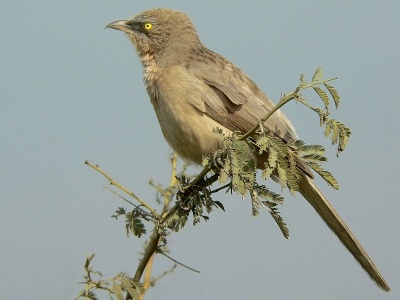
Photo © by Alok Tewari
Mangar Bani Forest, Faridabad-Gurgaon Road, Haryana, India, June-2018
- Argya malcolmi
Turdoides malcolmi
Identification
27–28 cm (10½-11 in); A quite large Turdoides babbler:
- White outer tail feathers on a long tail
- Black lores offsetting silvery forehead
- Pale eyes
- Dusky blotches on mantle
- Pale greyish rump and uppertail-coverts
Similar species
May be confused with Jungle Babbler, but note black lores and silvery forehead. Common Babbler has a dark eye and streaks above.
Distribution
Endemic to the Indian Subcontinent: northeast Pakistan, extreme southwest Nepal and much of India except the east.
Taxonomy
This is a monotypic species[1].
This species is sometimes placed in genus Turdoides.
Habitat
Open scrub country, cultivation, fallow land, open plantations, gardens, village environs.
Behaviour
The species is found in small flocks (usually around 10 birds) which keep in contact with loud nasal calls. Associates with Jungle Babbler.

Photo © by Alok Tewari
Keoladeo National Park, India, June-2017
Diet
Feeds on insects but may also take grain, seeds and berries.
Breeding
Breeds all year. Co-operative breeder. The nest is a neat cup, usually built with one or two helpers and made of grass, twigs and roots. It's placed in a bush or a small tree, about 1.2 to 3 meters above the ground. Lays 3 - 8 eggs. This species is parasitized by the Pied Cuckoo.
Vocalisation
Recording by Alok Tewari
Keoladeo National Park, India, June-2017
Individuals of a group calling and moving through trees and bushes at Sunset, engaged in end of the day foraging. Call of Indian Peafowl is heard in the BG, once. There is one very brief call by Rose-ringed Parakeet towards end.
References
- Clements, J. F., T. S. Schulenberg, M. J. Iliff, D. Roberson, T. A. Fredericks, B. L. Sullivan, and C. L. Wood. 2018. The eBird/Clements checklist of birds of the world: v2018. Downloaded from http://www.birds.cornell.edu/clementschecklist/download/
- Del Hoyo, J, A Elliott, and D Christie, eds. 2007. Handbook of the Birds of the World. Volume 12: Picathartes to Tits and Chickadees. Barcelona: Lynx Edicions. ISBN 978-8496553422
- Rasmussen, PC and JC Anderton. 2005. Birds of South Asia: The Ripley Guide. Barcelona: Lynx Edicions. ISBN 978-8487334672
Recommended Citation
- BirdForum Opus contributors. (2025) Large Grey Babbler. In: BirdForum, the forum for wild birds and birding. Retrieved 11 May 2025 from https://www.birdforum.net/opus/Large_Grey_Babbler
External Links
GSearch checked for 2020 platform.




